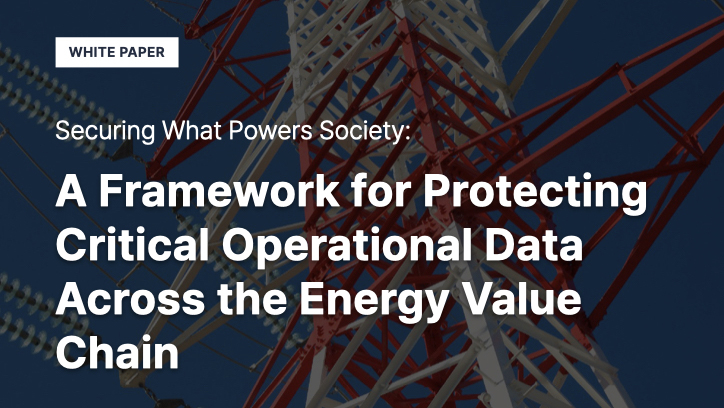Executive Insight
Energy is the lifeblood of modern society, and that lifeblood now runs on digital information. From plant schematics and SCADA (Supervisory Control and Data Acquisition) logs to maintenance manuals and outage reports, operational data flows continuously between utilities, contractors, regulators, and consumers. When that flow is compromised, trusted data becomes a liability, leading to misinformed decisions, system failures, and potential breaches of safety or compliance.
This white paper examines the points in the energy value chain where operational data becomes exposed, and presents a data-centric security framework that embeds protection into the data itself, strengthening operational resilience and ensuring regulatory compliance.
The Evolving Energy Landscape
The modern energy sector operates on a dual mandate: producing reliable sources of energy and generating vast streams of digital intelligence. Renewable plants, digital substations, distributed resources, smart meters, and EV charging infrastructure are transforming how energy is produced and consumed. At the same time, they are collapsing the once-clear boundary between information technology (IT) and operational technology (OT), creating a hyperconnected environment where every file, log, and manual becomes a potential attack surface.
What once flowed only within isolated networks now moves freely across cloud platforms, partner ecosystems, and mobile devices. This shift delivers efficiency and sustainability, but it also exposes critical operational data to unprecedented risks:
- Uncontrolled data flows: Plant schematics, system updates, and maintenance checklists circulate outside corporate oversight through email, USB drives, and personal cloud accounts.
- Visibility blind spots: Siloed IT and OT logs prevent organizations from knowing who accessed, revised, or shared sensitive files.
- Lingering access: Contractors and vendors often retain documents long after projects end, creating unmonitored pathways for redistribution.
The result is an expanded attack surface that traditional perimeter defenses cannot contain. This leaves critical infrastructure vulnerable to operational disruption and security incidents, not to mention the potential for financial losses, reputation damage, and even national instability.
This risk surface is not being exponentially amplified by the adoption of generative AI. Organizations are racing to deploy intelligent agents and Retrieval-Augmented Generation (RAG) chatbots trained on the very operational data that runs their facilities. The promise becomes transformative: empower a field technician to ask an AI for a specific repair sequence instead of digging through a 500-page manual.
Yet, this creates a sophisticated new threat vector. These AI models become conversational gateways to your most sensitive operational intelligence. An unsecured RAG agent can be manipulated to summarize confidential grid vulnerabilities for an unauthorized user or allow a former contractor to query sensitive schematics long after their access should have been revoked. Because the interaction is conversational, it can bypass traditional data loss prevention (DLP) tools that look for file transfers. Suddenly, the challenge is no longer just about controlling files, but about securing the questions and answers that can expose the secrets within them. This makes a data-centric security framework an urgent prerequisite for safely innovating with AI.
Critical Risk Zones Across the Value Chain
The interconnected energy value chain creates critical risk zones at every stage. As employees and partners continuously exchange sensitive operational data, they send it beyond the reach of corporate IT. Since the entire system has been designed to be interlinked, a single vulnerability can quickly cascade into widespread disruption.
Upstream Domain (Exploration & Production)
Engineering firms, OEMs (Original Equipment Manufacturers), and EPC (Engineering, Procurement, and Construction) contractors routinely share plant schematics, turbine specifications, and grid design blueprints to plan and construct infrastructure. These files often travel through email attachments, unmanaged FTP (File Transfer Protocol) servers, or personal cloud drives. Without persistent encryption, watermarking, or expiry controls, once a design file leaves the organization’s sphere of control, it can be duplicated, forwarded, or even resold without restriction. Unauthorized redistribution at this stage exposes the foundation of critical infrastructure before projects even break ground.
Key exposure paths include:
- Unsecured file sharing with partners: Through the normal course of business, engineering firms and OEMs often exchange critical design files through email, shared drives, or even USB sticks. These mechanisms sit outside the utility’s security controls, and once the files leave, the organization has no visibility or ability to stop them from being copied or resold.
- Vulnerabilities in vendor equipment: CISA (Cybersecurity and Infrastructure Security Agency) repeatedly warns about flaws in industrial control products – security threat mechanisms like weak authentication or remote code execution bugs. If these systems are not patched quickly, attackers can use them as a back door into the generation environment, gaining access long before a plant is operational.

